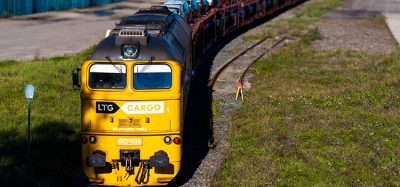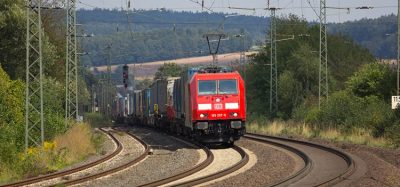Reducing CO2 emissions through new rail freight choices
Posted: 26 November 2007 | | No comments yet
Lowering CO2 emissions is central to all businesses these days. Within the rail freight industry, every day we are being asked to provide business with a way to reduce emissions generated by their transport choices. With rail freight emitting five times less CO2 per tonne kilometre moved than road haulage, the moment is now for railways across Europe to win additional volumes to rail. In less than 12 months, emissions per tonne mile moved have risen sharply up the agenda.
Lowering CO2 emissions is central to all businesses these days. Within the rail freight industry, every day we are being asked to provide business with a way to reduce emissions generated by their transport choices. With rail freight emitting five times less CO2 per tonne kilometre moved than road haulage, the moment is now for railways across Europe to win additional volumes to rail. In less than 12 months, emissions per tonne mile moved have risen sharply up the agenda.
Lowering CO2 emissions is central to all businesses these days. Within the rail freight industry, every day we are being asked to provide business with a way to reduce emissions generated by their transport choices.
With rail freight emitting five times less CO2 per tonne kilometre moved than road haulage, the moment is now for railways across Europe to win additional volumes to rail. In less than 12 months, emissions per tonne mile moved have risen sharply up the agenda.
Rail freight customers need reliable, secure and cost effective haulage, but they increasingly also need a low CO2 option. Everybody claims that they offer a good CO2 reduction option, but in the freight sector a new report by Professor Alan McKinnon of the Logistics Research Centre at Heriot-Watt University in Edinburgh (for the Climate Change Working Group of the Commission for Integrated Transport) has revealed who in domestic freight has low CO2 emissions.
The report examined the level of CO2 emissions from freight transportation in the UK, revealing that one way to reduce these emissions is to increase volumes being transported by rail, a mode that accounts for only 1.1% of all UK domestic CO2 transport emissions.
The report examines recent emissions data. In 2004, the best year for analytical results, all modes of domestic freight transport emitted a combined total of 33.7 millions tonnes of CO2 into the atmosphere.
HGVs accounted for 78.5% of these emissions, while vans contributed 13.3%. This is compared with waterway emissions which accounted for 6.8% and rail freight which contributed just 1.1%. Pipelines accounted for 0.3% and air, as a minor player in this market but with high emission levels, accounted for 0.1%.
The report also stated that freight transport is responsible for just over 21% of all CO2 emissions in the transport sector and roughly 6% of the total CO2 emissions in the UK.
Given these facts, it is clear why rail freight forms part of the Government’s thinking towards lowering CO2. The £200 million funding for the strategic rail freight network announced in the recent White Paper, and the announcement at the end of October of a further £132 million for specific rail freight infrastructure, puts Government funding for rail freight at a level not seen for decades. This investment in rail freight will not only result in volume growth but importantly will reduce CO2 levels and the 21% share freight has for all transport emissions.
In examining opportunities to cut CO2 emissions, the report states that average CO2 emissions per tonne-km are substantially lower for rail and waterborne transport than road and air. Professor McKinnon writes that “shifting freight to these more environmentally-friendly modes can therefore cut CO2 emissions.”
EWS believes that this report from Professor McKinnon should be read by every company with a haulage requirement that is committed to reducing CO2 emissions. For the first time in one report, the true scale of the domestic freight transport market’s carbon emissions can be studied. It is important that the report is used as a blueprint for transport to reduce its CO2 emissions.
EWS is already addressing the key themes in the report to help the British economy increase its use of rail freight and in doing so lower CO2 emissions. We recognise that we must lead in order to seek this reduction.
The recent summer months have seen an increase in EWS’s involvement in the fast moving consumer goods sector, with flows of fresh produce being moved for supermarkets. We have also just conducted the first major trial using 100% bio fuel on one of our trains, and are working on detailed plans to lower our carbon emissions significantly over the coming years, reducing further the level of CO2 emissions from our freight trains.
Taking a more international view, the revised pricing arrangements Eurotunnel charges rail freight operators to the Channel Tunnel is tremendous news. The new charges will provide greater clarity on costs and stimulate the movement of intermodal traffic on longer trains, thereby playing a major part in the reduction of transport’s carbon footprint.
We look forward to operating more freight trains through the Channel Tunnel in the coming months, not only to see the traffic grow but to see a shift from road to rail right across Europe. In doing so, European CO2 levels will fall.
I mentioned earlier the historic funding for rail freight. Government policy for rail freight has been reinforced by funding the necessary infrastructure improvements required to deliver its vision, which is a significant milestone in the creation of an enhanced freight railway network. The Department for Transport’s vision of a 30% growth in rail freight by 2014 and a reduction in CO2 levels is to be applauded.
While funding and Governmental support for rail freight growth is good news, the challenge today is to continue to increase the volume of rail freight on the existing network. Ever increasing demand will create problems in the future unless we continue to identify small enhancement projects that can deliver big results for the country. For that reason, EWS, with the rest of the rail freight industry, has identified railway enhancement schemes that provide simple improvements but with a big impact.
Covering England, Wales and Scotland, they might not be the headline grabbing multi-billion pound projects, but they do provide a more flexible network that enables the growth in rail freight to continue for modest investment.
By investing in these schemes, we not only ensure we provide low cost capacity for rail freight expansion, but we also ensure that we can continue to grow and lower the nation’s level of CO2 emissions.
The following list identifies these enhancements. I have been in the rail freight sector for my entire railway career. The environment has always been an issue, but the case for it always seemed to come and go depending on political fashion. Those fashion led days are now over. The seriousness of the CO2 issue requires a serious solution. The job of the railway is to work with Government to lower these emissions and protect our planet for tomorrow. The rail freight sector is doing its job.
Current rail freight enhancement projects for growth and to reduce CO2 include the following:
Wales
- Blaenau Ffestiniog: This is to enhance route capability to allow slate waste train operations. The route is currently only capable of supporting sprinter style passenger trains.
- Newport – Shrewsbury: This project is to provide additional capacity and enhanced loop length and capability. This is an important route between South Wales, England and North Wales. The route has long signalling sections which limits the capacity of the route, but modern signalling would enhance the capacity.
- Cardiff – Bristol: This is to enhance the Severn Tunnel capacity and increase relief line speeds. Relief lines currently have a line speed of between 40mph and 60mph. Raising the speed to 60mph throughout for bulk freight and 75mph for container trains would add capacity to the route and reduce journey times. Also, Severn Tunnel is over four miles long with no intermediate signals. Installing signals in the tunnel would add capacity and reduce journey times.
- Cwmbargoed branch line: This is to improve operations by enhancing line speeds and the creation of new loops. An increase in linespeed of this line to 30mph would reduce the journey time, while a loop located intermediately on the single track branch or Ystrad Mynach in the northbound direction would allow freight to be operated with minimum impact on the regular passenger services.
- Cardiff Central to Cardiff Queen Street: A project for additional signalling capacity. The current three minute signalling headway restricts capacity for freight and passenger services between these points. Reducing the signalling headways and minor adjustments to the passenger service would create regular freight service opportunities.
Scotland
- W12 gauge enhancement from Berwick to Glasgow, including the Shotts line: The route into Scotland from the eastern side of Britain is currently cleared to W9. Expansion to W12 would enable 9ft 6” containers to be conveyed on this route. At present, only the West Coast Main Line can provide access for this size of container to Scotland.
- Run round facilities at Kilmarnock: There are coal loading points adjacent to the Glasgow & South Western Line, where coal is exported to English power stations. Trains need to travel north and run on a loop between Kilmarnock, Barassie, Newton on Ayr and Mauchline junction before they can travel south. This wastes capacity and can be avoided by a run round facility at Kilmarnock. Another loop is required at Kilmarnock to facilitate the construction of the Glasgow Airport Rail Link project.
- Electrification between Monktonhall junction and Slateford junction via Craiglockhart: The main passenger route through Edinburgh Waverley station is electrified while the main freight route via Millerhill is not. This requires electricity hauled freight trains to use Waverley station or change locomotives at Millerhill. Electrification of the Millerhil route would avoid this current operation. Also, the route between Craiglockhart and Haymarket West/Central Junction should be electrified to connect with the planned re-opening of the electrified Airdrie to Bathgate line.
- Gauge enhancement of Glasgow & South Western route to W12: The West Coast Main Line is currently cleared to W9 and W10 gauge for container traffic. If this route is closed, there is no alternative route available. Clearing the Glasgow & South Western route to W12 provides an alternative route between Gretna and Glasgow.
- Gauge enhancement from Mossend/Edinburgh to Grangemouth to W12: Coupled with the gauge enhancement on the East Coast Main Line between Berwick and Glasgow, an obvious extension is to extend W12 gauge clearance from Edinburgh to Grangemouth via Polmont. This would allow gauge cleared access from both directions at Grangemouth.
- Removal of weight restrictions: On the Scottish rail network there are some weight restrictions. These affect loaded freight trains by requiring a speed restriction mainly due to under bridges and track formation. Removing these restrictions at Paisley Gilmour Street, Annbank, Plean and Stirling would allow freight trains to operate at normal linespeed without slowing down to cross the affected area.
- Lengthen loops and moving signals to allow longer coal trains to operate: The length of coal trains from the Port of Hunterston has increased to 23 HTA wagons per train. The existing loops on the rail network were provided for historic shorter trains and enhancing the loop length will enable better use to be made of each freight path on the network and add capacity to the routes.
- Capacity improvements between Edinburgh and Inverkeithing: The headway between trains on the Queensferry to Inverkeithing section is currently seven minutes. This restricts capacity on the Forth Bridge, the Fife Circle and Perth. An additional intermediate signal would enhance the capacity of the route. There is also a five minute allowance required for all freight trains crossing the Forth Bridge, placing a restriction on freight trains and the overall capacity of the route. Reducing this allowance would therefore help the overall capacity of the network.
- Transfer of Millerhill signal box to Edinburgh IECC signal centre: The existing Millerhill signal box controls the area around Millerhill Yard. The second phase of works at Waverley station should include the transfer of the Millerhill signal box to Edinburgh. This will allow better control of the area, as the Edinburgh signalling centre would control the entire route from one place, eliminating the need to secure and clip points at Millerhill if passenger trains need to be diverted.
England
- Channel Tunnel routes, gauge enhancement to W12 and full European gauge: The current maximum gauge permitted on the routes from the Channel Tunnel to London and beyond is W9. To increase the volume of business available to rail there needs to be a two stage gauge enhancement project. First, to enhance gauge to W12, allowing the movement of additional European rail vehicles and deep sea containers. Second, to enhance a route linking the Channel Tunnel Rail Link with the West Midlands, North West and Yorkshire for full European gauge traffic. Together these gauge enhancements will allow rail to compete for new traffic and generate a greater level of traffic between the UK and the Continent.
- Transpennine routes and Newcastle to Carlisle gauge clearance: The current national gauge network for W9 and W10 does not provide a through East – West route between the ECML and WCML. This means that gauge dependant trains cannot link the ports and terminals in an East – West direction through the Pennines, or between Carlisle and Newcastle. A gauge cleared route is therefore needed to provide the solution. This would allow the ports of Liverpool and Seaforth in the West as well as Hull and Immingham in the East to move containers by rail on standard wagons to the terminals in the North West and North East.
- Felixstowe and Southampton train length: The Channel Tunnel freight routes were designed to accommodate 775m length trains, allowing each train to maximise the amount of goods conveyed. The ports of Felixstowe and Southampton are the largest ports in the country for containers. The need to maximise the use of each train is therefore essential. This will contribute to increasing rail’s capacity from the port and allowing rail to grow with the ports and to expand its market share. Increasing train length to 775m will require investment in loops on the network and terminals.
- Oxford to Bletchley re-opening to provide additional capacity and diversionary capability: The route between Southampton and the West Coast Main Line has no diversionary route on the section between Didcot and Leamington Spa. If the route between Oxford and Bletchley reopened as a through route, it would provide the diversionary route. At Bletchley it links into the West Coast Main Line which is already gauge cleared.
- Stourbridge to Walsall re-opening: There are significant freight flows on the route between Bristol and the West Midlands. Reopening the Stourbridge to Walsall line would provide an alternative route for freight trains. By using this route the trains avoid the Lickey incline; the steepest gradient on the English main line network. It would also reduce freight trains movements on a main passenger route.
- Hope Valley capacity improvements: This route is primarily used by construction trains, with a limited amount of imported coal. This route has restrictive capacity caused by the old signalling system. The exact spacing of the fast passenger trains by 30 minutes also restricts the overall capacity of the route. Modern signalling would provide a step change in capacity.






